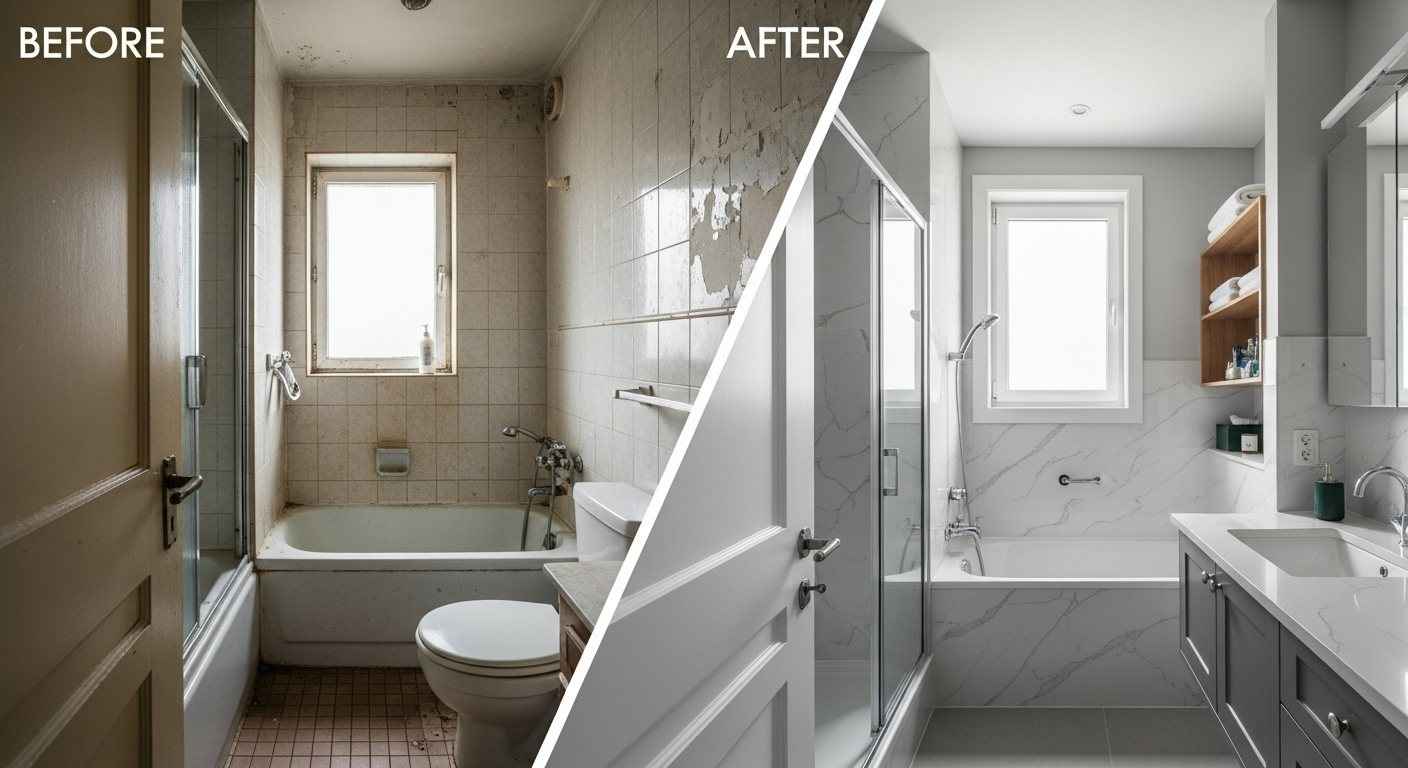Considering a bathroom remodel? One of the most common questions I hear, after decades in the business, is, “How long does it take to remodel a bathroom?” My honest answer is, and always will be, “It depends.” This isn’t a vague response; it’s the absolute truth. Unlike baking a cake with a precise timer, a bathroom renovation timeline is influenced by numerous variables. Providing a single, fixed duration would be misleading.
- The Full Bathroom Remodel Timeline: What to Expect
- Phase 1: Demolition (Typically 1-2 Days)
- Phase 2: Rough-Ins (Plumbing, Electrical, HVAC – 3-7 Days)
- Phase 3: Inspections & Drywall Installation (2-4 Days)
- Phase 4: Flooring & Tile Installation (3-7 Days)
- Phase 5: Cabinetry, Fixtures & Painting (4-7 Days)
- Phase 6: Finishing Touches & Cleanup (1-2 Days)
- Cosmetic vs. Full Bathroom Remodel: Different Timelines
- The Crucial Planning & Design Phase: Before Construction Begins
- Defining Your Bathroom Renovation Vision & Budget
- Choosing Your Contractor & Getting Bids
- Finalizing Design Decisions & Drawings
- Material Lead Times: The Hidden Factor in Your Remodel Schedule
- Standard vs. Custom Bathroom Materials
- Understanding Supply Chain Realities
- Proactive Ordering for a Smooth Timeline
- Common Delays That Extend Your Bathroom Renovation Timeline
- Permits & Building Inspections
- Unforeseen Structural & Hidden Issues
- The Impact of Change Orders
- Contractor Availability & Scheduling Conflicts
- Setting Realistic Expectations for Your Bathroom Project
- Your Beautiful New Bathroom: A Journey Worth Taking

Instead, this guide will offer a realistic breakdown of each phase, explain common delays, and equip you with the knowledge to set clear expectations. My aim is to help you understand the journey ahead, because a well-informed homeowner is always a happier homeowner, especially when embarking on a significant project like a bathroom renovation.
The Full Bathroom Remodel Timeline: What to Expect
Let’s talk about a full gut remodel – the kind where we’re ripping everything out and starting fresh. This isn’t just a weekend project; it’s a significant undertaking. In my experience, a comprehensive bathroom remodel, executed by a professional crew, typically takes anywhere from three to eight weeks of active construction. This duration does not include the essential planning phase, which we’ll delve into later.
Each phase of a bathroom remodel timeline has its own rhythm and challenges, and understanding them is key to setting realistic expectations for your bathroom renovation.
Phase 1: Demolition (Typically 1-2 Days)
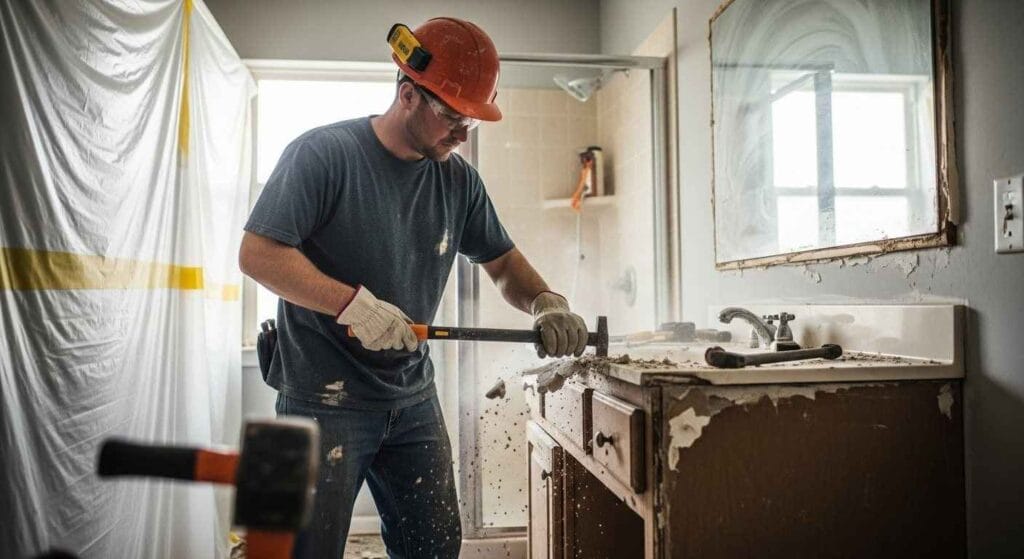
This is where the fun begins, and sometimes, the surprises. We’re tearing out the old vanity, toilet, shower, and often the flooring and wall tile. It’s messy, noisy work, but it usually moves pretty fast. The main thing here is to protect the rest of your home from dust and debris using plastic sheeting, floor coverings, and sometimes even negative air machines.
The biggest potential hang-up? Discovering significant issues like mold or rot once the walls are open. That can quickly shift this from a one-day job to a two-day job, and sometimes even more if remediation is needed, thus impacting your bathroom renovation timeline.
Phase 2: Rough-Ins (Plumbing, Electrical, HVAC – 3-7 Days)
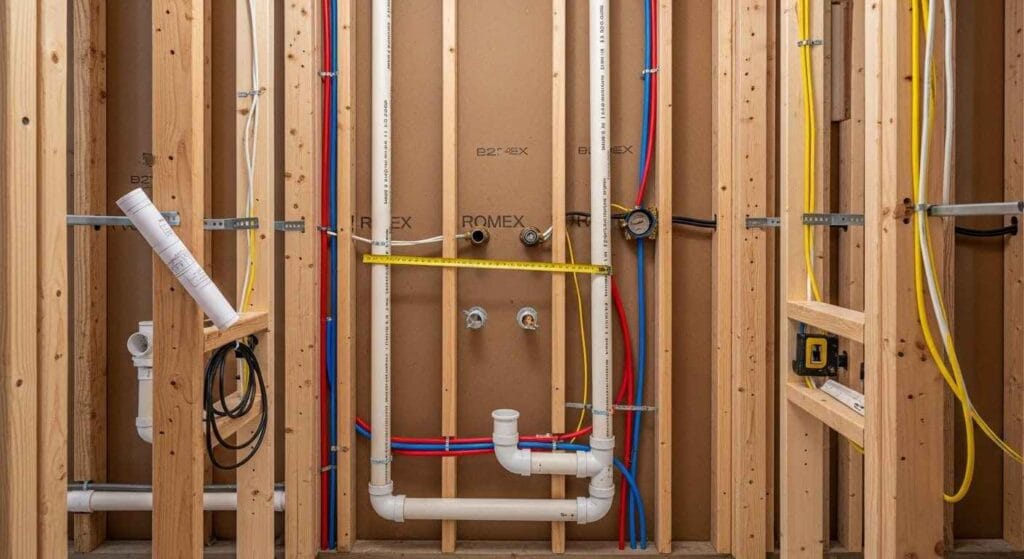
Once everything’s stripped down, it’s time for the “rough-ins.” This is where the new layout takes shape, but it’s all behind the walls. Plumbers will run new water lines (PEX or copper) and drain pipes (PVC), repositioning them for your new fixtures. Electricians will pull new wiring for light fixtures, outlets, and exhaust fans.
If you’re upgrading to a heated floor system, that electrical work happens here too. Sometimes we’ll even adjust HVAC ducts if the new layout demands it. This phase requires skilled tradespeople, and their availability can sometimes be a factor in your bathroom remodel timeline. Coordination is critical here; everyone needs to work together to ensure everything is up to code before the walls are closed back up.
Phase 3: Inspections & Drywall Installation (2-4 Days)
After the rough-ins are complete, but before anything gets covered up, the local building inspector needs to come out and approve the work. This is a non-negotiable step and can sometimes add a few days if scheduling an inspector is tough, or if there are any minor adjustments required.
Once approved, we’ll install new cement board for wet areas (like the shower) and drywall for the rest of the walls and ceiling. Taping, mudding, and sanding drywall is an art form that takes time and often multiple coats with drying time in between. Don’t rush this; a poorly finished wall will show every imperfection through the paint, affecting the final look of your bathroom renovation.
Phase 4: Flooring & Tile Installation (3-7 Days)
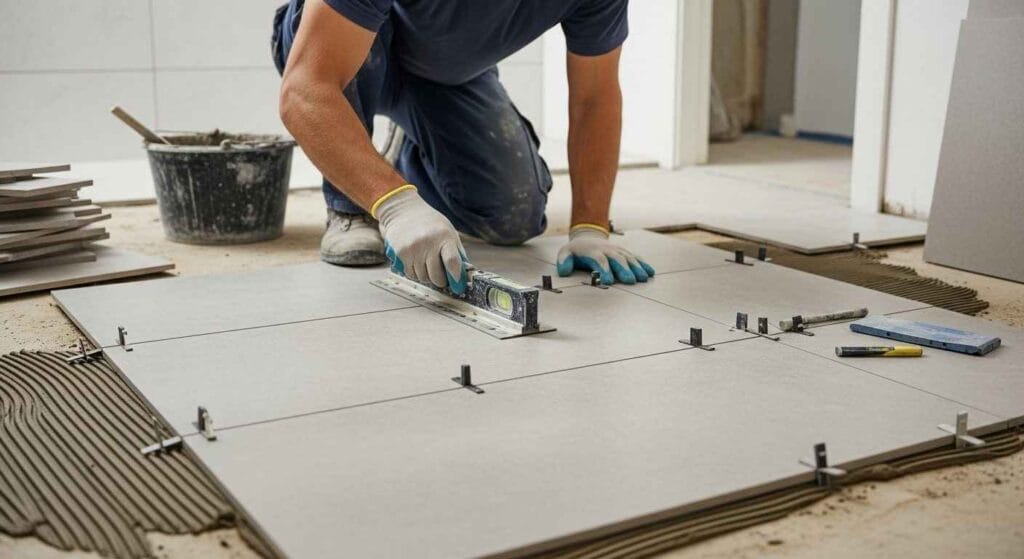
Now for the visible progress! This is typically where we install the floor tile, wall tile (especially in the shower), and any decorative accents. Setting tile requires precision, and depending on the complexity of the pattern or the size of the tile, it can be quite time-consuming. Larger format tiles, intricate mosaics, or complex layouts like herringbone can take longer to install.
After the tile is set, it needs a full 24-48 hours to cure before it can be grouted. Then, the grout itself needs to cure for another 24-72 hours before sealing. Skipping these curing times is a common mistake that can lead to problems down the road. I always remind homeowners that patience here pays off in a lasting, beautiful bathroom remodel.
Phase 5: Cabinetry, Fixtures & Painting (4-7 Days)
With the floors and walls in, we install your new vanity, countertops, toilet, and shower fixtures. Painting follows, often after the vanity is set, but before the final plumbing trim is installed to avoid drips on new finishes. Installing lighting fixtures, mirrors, and shelving also happens during this period.
The quality of the installation here really defines the finished look of your bathroom renovation. We’re talking about precise measurements and careful handling of delicate materials.
Phase 6: Finishing Touches & Cleanup (1-2 Days)
This is the final stretch – the trim work, putting on switch plates and outlet covers, hanging the shower door (which often requires a separate specialized installer), and a thorough clean-up. Small details make a big difference in the overall feel. Once all the dust is gone and every last piece is in its place, your beautiful new bathroom is ready for use.
On a recent project in a historic home, we actually ran into a slight issue with the shower door fitting perfectly due to an unlevel wall we discovered late in the game. It added a half-day for a custom trim piece, but it was worth it for the perfect finish and to maintain the quality of the bathroom remodel.
Cosmetic vs. Full Bathroom Remodel: Different Timelines
Not every bathroom project is a full gut remodel. Sometimes, you just want to freshen things up without changing the layout or moving plumbing. These “cosmetic updates” are a different beast entirely when it comes to time, often dramatically shortening your bathroom renovation timeline.
Quick Cosmetic Updates (3-7 Days)
If you’re simply painting the walls, swapping out an existing vanity for a new one (provided the plumbing lines up perfectly), replacing light fixtures, or installing a new toilet, you’re looking at a much shorter timeline. These types of projects can often be completed in as little as three to seven days of actual work.
The key here is that no walls are being opened, and no plumbing or electrical is being relocated. It’s surface-level stuff. For instance, just last month we did a refresh for a client that involved new paint, a new pre-fab vanity, a new toilet, and some updated sconces. We were in and out in four days, and it made a massive difference to the room’s appeal without touching the tile, offering a rapid bathroom transformation.
Understanding “Minor” vs. “Major” Updates
It’s crucial to understand what truly constitutes “minor.” If you want to change the shower tile but keep the pan, that’s still a significant tiling job. If you want to replace a tub with a walk-in shower, that’s a major plumbing and framing alteration, not a minor update.
Even moving an electrical outlet by six inches can necessitate opening walls, running new wires, and getting an inspection – suddenly, your “minor” electrical tweak has blossomed into a multi-day mini-project. The line between cosmetic and structural is often thinner than homeowners realize, and misjudging it is a common source of schedule creep in a bathroom remodel timeline. Always consult with a professional if you’re unsure about the scope.
The Crucial Planning & Design Phase: Before Construction Begins

Before a single sledgehammer hits a wall, there’s a massive amount of invisible work that goes on. This planning and design phase is arguably the most critical and often the most underestimated part of the entire process. It typically spans one to four weeks, sometimes even longer, before construction ever begins. Don’t skip or rush this. It’s where you prevent problems, not solve them, ensuring a smoother bathroom renovation.
Defining Your Bathroom Renovation Vision & Budget
This is where you figure out what you want. What’s your style? What features are essential? What’s your absolute maximum budget for your bathroom remodel? Spend time on Pinterest, visit showrooms, and gather inspiration. Having a clear vision, even if it’s just a general aesthetic, helps immensely.
A realistic budget is also paramount; knowing what you can afford steers your design and material choices from the outset. I always tell folks, spend a little extra time on this and avoid expensive changes later in your bathroom remodel timeline.
Choosing Your Contractor & Getting Bids
Finding the right contractor is like finding a good doctor – you want someone skilled, trustworthy, and with whom you can communicate effectively. This involves researching, calling references, reviewing portfolios, and getting detailed bids from multiple professionals. Don’t just pick the cheapest; pick the one you trust and who demonstrates a clear understanding of your bathroom renovation project.
This process can easily take a week or two, especially if you’re waiting for detailed proposals. On my end, providing a comprehensive bid takes time and involves several visits to the site to ensure accuracy.
Finalizing Design Decisions & Drawings
Once you have a contractor, or perhaps an interior designer, you’ll start finalizing the nitty-gritty details. This means choosing specific tiles, paint colors, vanity styles, faucet finishes, lighting fixtures, and more. This can be overwhelming with the sheer number of options available today for a bathroom remodel.
Professional drawings or 3D renderings might be created to ensure everyone is on the same page. Every single fixture and material needs to be decided upon and noted in the project plan. Making changes once construction has begun is one of the fastest ways to blow up your timeline and your budget. That’s why we lock down these decisions beforehand.
Material Lead Times: The Hidden Factor in Your Remodel Schedule
This is a big one, folks, and it’s where many projects hit unexpected snags. The era of walking into a big box store and having everything you need immediately is, for many specialized items, long gone. Material lead times can range from four to twelve weeks, and sometimes even longer. You absolutely need to factor this into your overall bathroom remodel timeline, before demolition day.
Standard vs. Custom Bathroom Materials
Your choices here heavily influence the waiting game. Standard, in-stock ceramic or porcelain tiles from a major retailer might be available right away. But if you’re dreaming of a specific handmade Zellige tile from Morocco, a custom-sized vanity, or a particular slab of Calacatta marble for your countertop, you’re going to wait.
High-end plumbing fixtures from brands like Waterworks or even some specific finishes from Kohler or Delta can have significant lead times, especially if they’re not standard inventory. We had a client recently who wanted a very specific shower panel system, and it was back-ordered for nearly three months. We had to adjust the entire schedule around that single item, directly impacting the bathroom renovation timeline.
Understanding Supply Chain Realities
The world has changed. Global supply chain issues are still a very real factor. What might have been a two-week lead time pre-pandemic could now be eight or ten weeks. I’ve seen everything from toilet bowls to shower valves to specific paint colors experience delays. It’s not always predictable, but it’s always a possibility.
This is why ordering materials well in advance of your planned start date is non-negotiable for a smooth bathroom remodel project. Ideally, we want all major materials on site, or at least confirmed and en route, before demolition begins.
Proactive Ordering for a Smooth Timeline
My advice is simple: order everything you can as early as possible. Don’t wait for rough-ins to be done before ordering your toilet. Don’t wait for tile installation to begin before ordering your grout. Your contractor should help you create a detailed material list with estimated lead times.
Once confirmed, place those orders. Store items securely if necessary, but having them ready ensures that once construction starts, there are no pauses waiting for a crucial component. This proactive approach is the single best way to mitigate lead time risks and keep your bathroom renovation timeline on track.
Common Delays That Extend Your Bathroom Renovation Timeline
Even with the best planning, some things are simply out of our control or arise unexpectedly. Understanding these common culprits can help you prepare for potential delays in your bathroom remodel.
Permits & Building Inspections
For most significant bathroom remodels, you’ll need permits for plumbing, electrical, and sometimes structural work. Getting these permits approved by your local municipality takes time – anywhere from a few days to several weeks, depending on your jurisdiction and the complexity of the project.
As mentioned, inspections are also required at various stages (rough-in, final), and scheduling these can add a day or two each time. Never skip permits; it’s illegal and can cause huge headaches down the road, impacting your overall bathroom renovation duration.
Unforeseen Structural & Hidden Issues
This is a classic. We tear out an old shower, and what do we find? Rotting floor joists from a slow, persistent leak that’s been going on for years. Or we open a wall and discover old, ungrounded wiring that needs to be brought up to code. These “surprise” issues are common in older homes and can add days or even weeks to a project, not to mention extra costs.
We have to address them properly; you can’t just cover up rot or faulty wiring. This is why having a contingency fund and a flexible bathroom remodel timeline is always a smart move.
The Impact of Change Orders
This is perhaps the biggest timeline killer. You start construction, see something taking shape, and decide you want to change the tile, move an outlet, or upgrade a fixture. Each change order requires pausing work, revising plans, getting approvals, potentially re-ordering materials, and rescheduling trades. Even a seemingly small change can have a domino effect.
My advice? Make all your decisions during the planning phase and stick to them. It saves both time and money, and keeps your bathroom renovation timeline predictable.
Contractor Availability & Scheduling Conflicts
Good contractors are busy contractors. If your project starts during a peak season or if you have highly specialized tasks that require specific tradespeople (like custom glass installers for a shower enclosure), there can be delays if their schedules are tight.
A reputable contractor will be transparent about their availability and will schedule sub-contractors efficiently, but sometimes, things just don’t align perfectly. This can slightly extend the bathroom remodel timeline.
Setting Realistic Expectations for Your Bathroom Project
Given all these variables, the most important thing you can do as a homeowner is to set realistic expectations for your bathroom remodel. Don’t plan your daughter’s graduation party in your newly renovated bathroom the week after the projected “finish” date.
Clear Communication with Your Contractor
Work closely with your contractor. Ask questions. Understand the process. A good contractor will keep you updated on progress, potential delays, and any issues that arise. You should feel comfortable communicating your concerns and understanding the explanations provided, ensuring a smooth bathroom renovation.
Building a Buffer into Your Timeline
Always build a buffer into your personal timeline. If your contractor gives you a range of 3-8 weeks for your bathroom remodel, assume it might take closer to the 8-week mark, or even slightly longer, especially if unforeseen circumstances arise. Life happens, and construction projects are no exception. Giving yourself that extra wiggle room will reduce stress and prevent disappointment. Think of it as investing in your peace of mind.
Your Beautiful New Bathroom: A Journey Worth Taking
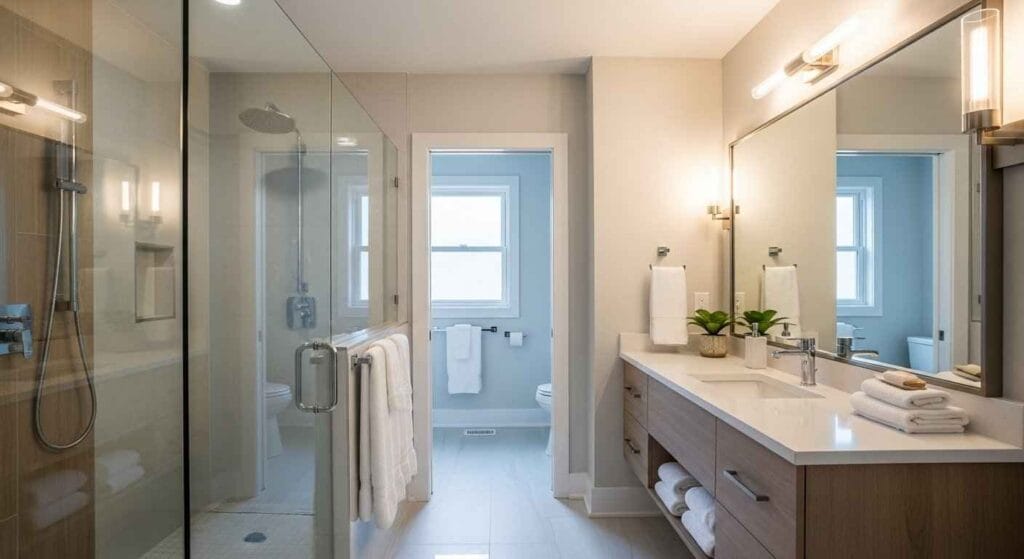
A bathroom remodel is a significant investment of time, money, and emotional energy. While there’s no single, magic answer to “how long does it take to remodel a bathroom,” a comprehensive renovation typically involves three to eight weeks of active construction, often preceded by an equally long planning and design phase.
By understanding these distinct phases, preparing for potential delays like material lead times and unforeseen structural issues, and maintaining open communication with your chosen contractor, you can navigate the journey with confidence. My ultimate goal, as a seasoned professional, is for you to love your beautiful, functional new bathroom for years to come, without the stress of avoidable surprises. Ready to start planning your dream bathroom? Contact us today for a consultation and a detailed estimate tailored to your project. Focus on preparation, manage your expectations, and you’ll be well on your way to a successful transformation.
Can a bathroom be remodeled in just a few days?
Only for the most basic cosmetic updates, like painting, swapping a vanity for one with identical plumbing, or replacing a toilet. Anything involving opening walls, moving plumbing, or tiling will take significantly longer. Don’t fall for unrealistic promises about a rapid bathroom renovation.
What’s the longest part of a bathroom renovation?
Often, it’s a combination of the planning and material lead times before construction begins, and then the tiling and finishing stages during construction. Tiling requires careful installation and curing times, while lead times for custom or specific materials can stretch for months, significantly impacting the bathroom remodel timeline.
How can I speed up my bathroom remodel timeline?
The best way is through thorough planning and proactive material ordering. Make all your design and material decisions upfront, have everything on-site before demolition, avoid change orders, and work with an experienced contractor who can manage the schedule efficiently. This helps ensure your bathroom renovation moves as quickly as possible.




